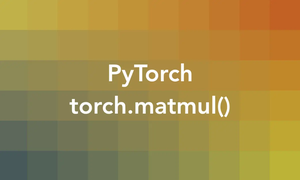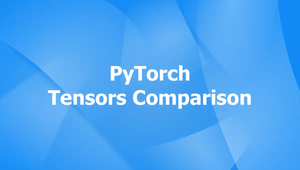Flattening a tensor in PyTorch means reshaping it into a one-dimensional tensor (1D tensor). This concise, example-based article will show you a couple of different ways to do so.
Using the torch.flatten() function
This approach uses the torch.flatten() function, which might be the best choice for the task. It is simple and flexible. The function can flatten the whole tensor or a subset of dimensions. It does not depend on the contiguity or copying behavior of the input tensor.
Syntax:
torch.flatten(input, start_dim=0, end_dim=-1) -> TensorWhere:
input: The input tensor that you want to flatten. It can have any shape and data type.start_dim: The first dimension to flatten, counting from zero. The default value is zero, which means to flatten from the first dimension. You can also use negative values to count from the end, such as-1for the last dimension.end_dim: The last dimension to flatten, counting from zero. The default value is-1, which means to flatten until the last dimension. You can also use negative values to count from the end, such as-2for the second last dimension.
Example:
import torch
# Create a 3x2x4 tensor
x = torch.tensor([[[1, 2, 3, 4],
[5, 6, 7, 8]],
[[9, 10, 11, 12],
[13, 14, 15, 16]]])
# Flatten the whole tensor
y = torch.flatten(x)
print(y)
# tensor([ 1, 2, 3, 4, 5, 6, 7, 8, 9, 10, 11, 12, 13, 14, 15, 16])
print(y.shape)
# torch.Size([16])
# Flatten only the last two dimensions
z = torch.flatten(x, start_dim=1)
print(z)
# tensor([[ 1, 2, 3, 4, 5, 6, 7, 8],
# [ 9, 10, 11, 12, 13, 14, 15, 16]])
print(z.shape)
# torch.Size([2, 8])Using the Torch.view() method
This approach is fast and memory efficient as it does not copy the data, but the downside is that it only works on contiguous tensors and requires specifying the desired shape explicitly. There are two main steps:
- Check if the input tensor is contiguous by calling
Tensor.is_contiguous(). If not, make it contiguous by callingTensor.contiguous(). - Call
Tensor.view()on the tensor with-1as the argument to infer the shape of the output tensor.
The syntax of the Tensor.view() method is as follows:
Tensor.view(*shape) -> TensorWhere:
self: The input tensor that you want to reshape.*shape: Either atorch.Sizeobject or a sequence of integers that determine the desired shape of the output. You can also use-1to infer the size of a dimension from the other dimensions.
Example:
import torch
# Create a non-contiguous (transposed) tensor
x = torch.tensor([[1,2],[3,4],[5,6]]).transpose(0,1)
print(x)
# tensor([[1, 3, 5],
# [2, 4, 6]])
print(x.is_contiguous())
# False
# Make it contiguous
x = x.contiguous()
print(x.is_contiguous())
# True
# Reshape it into a one-dimensional tensor
y = x.view(-1)
print(y)
# tensor([1, 3, 5, 2, 4, 6])
print(y.shape)
# torch.Size([6])You can find more details about the Torch.view() method in this article. Happy coding & have a nice day!








